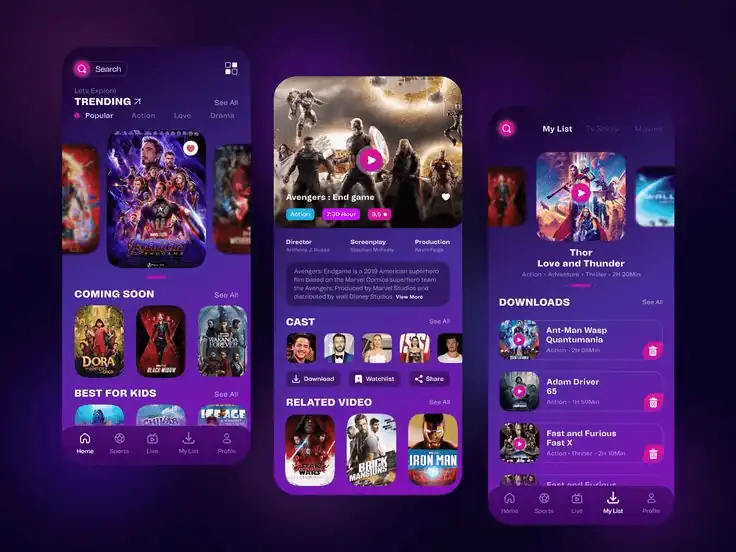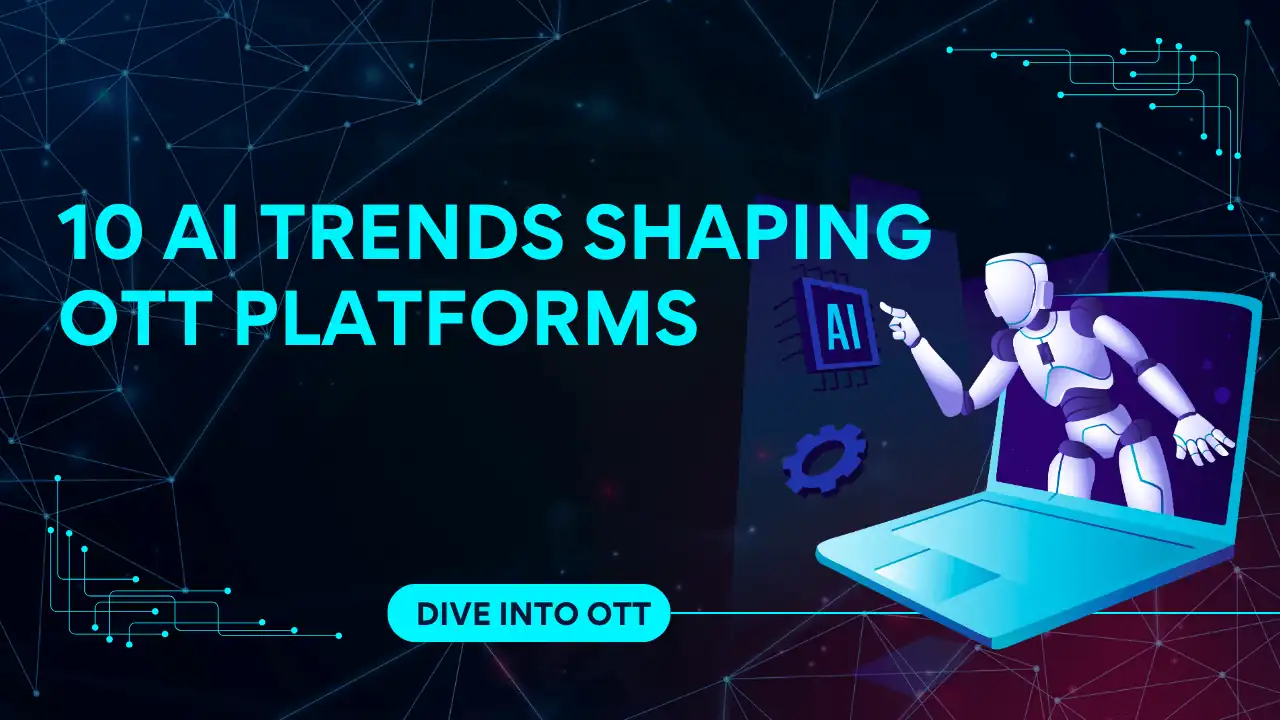Introduction: Why AI is the Game-Changer for OTT Platforms
The OTT (Over-the-Top) industry is no longer an alternative to traditional TV — it is the future of entertainment, education, sports, and live events. From giants like Netflix and Disney+ to regional leaders such as Sony LIVE and Hotstar in India, OTT platforms are redefining how people consume video content.
But here’s the challenge: audience demand is skyrocketing while competition among OTT platforms is fierce. Users want personalized experiences, no buffering, multilingual support, and affordable subscription models. Providers need smarter monetization strategies, better content discovery, and ways to reduce churn.
This is where Artificial Intelligence (AI) steps in.
A PwC report predicts that by 2025, over 80% of OTT platforms worldwide will rely on AI-driven features — from recommendation engines to ad optimization — to stay competitive. AI is not just a backend feature anymore; it is the core differentiator between successful OTT platforms and those that fade away.
If you’ve been searching for what is an OTT platform, OTT platform meaning, or how to build OTT apps that make money, this blog is your complete guide to understanding how AI is revolutionizing OTT streaming solutions in 2025.
AI in OTT: 10 Transformations You Need to Know
Artificial Intelligence is solving some of the biggest pain points for OTT solution providers, content creators, and platform owners. Let’s explore how.
1. Smarter Content Discovery & Hyper-Personalized Recommendations
Finding the right show or movie in a massive library can be overwhelming. That’s why the best OTT platforms in 2025 use AI-powered recommendation systems.
- Machine learning algorithms track user behavior — watch time, skipped videos, liked content — to build hyper-personalized feeds.
- AI-driven OTT video solutions also consider external data like trending topics, location, and even time of day to recommend content.
Example: Netflix claims that 80% of the content watched on its platform is discovered through AI recommendations. For smaller players looking to create an OTT platform, adopting AI recommendations can help compete with giants by keeping users engaged longer.
Platforms with AI-driven discovery see up to 50% higher engagement rates than platforms without it (Statista, 2025).
2. AI-Optimized Video Streaming & Bandwidth Efficiency
Buffering and poor video quality are deal-breakers for users. AI addresses this with:
- Adaptive bitrate streaming that adjusts quality automatically.
- Predictive network optimization to detect when a user’s internet may drop.
- AI video compression to reduce file sizes while keeping quality intact.
OTT platforms in India, where data costs are a big concern, especially benefit from AI bandwidth optimization.Other OTT solution providers now include AI-based compression as a default feature in their white label OTT platforms.
Platforms report 30% lower bandwidth costs and 40% fewer user complaints when AI optimization is enabled.
3. Automated Content Moderation for Safer OTT Experiences
With user-generated content and live video streaming solutions becoming popular, moderation is critical. AI tools scan for:
- Inappropriate visuals, hate speech, or copyrighted material.
- Pirated content uploads in real-time.
- Spammy behavior in chat-driven live streaming apps.
For example, YouTube uses AI to detect and remove over 90% of harmful content before users flag it. Smaller OTT streaming platforms adopting similar AI tools can build safer ecosystems without huge moderation teams.
This is especially important for education, corporate training, and religious live streaming platforms, where compliance and safety are a must.
4. AI-Powered Dynamic Ad Insertion for Better Monetization
OTT monetization strategies often fail when ads are irrelevant or annoying. AI solves this through:
- Dynamic Ad Insertion (DAI): Ads are inserted mid-stream without buffering.
- Contextual targeting: Ads match the content being streamed.
- Personalized campaigns: Viewers see different ads based on their profile.
Example: A user watching a cricket live streaming app in India may see sports equipment ads, while another in the US sees betting or food delivery ads. Same content, different ads — thanks to AI.
According to eMarketer, OTT ad spend in 2025 will exceed $247 billion globally, with AI-driven personalization contributing to over 60% of the growth.

5. Predictive Analytics Shaping OTT Content Strategy
Choosing which shows to produce or license is risky and expensive. AI predictive analytics makes it smarter by:
- Forecasting viewership for new releases based on historical data.
- Analyzing social media chatter to predict viral hits.
- Measuring content fatigue to know when users might stop watching.
Example: Disney+ uses AI to decide release timing for Marvel series by analyzing audience peaks from past launches. Smaller players using end-to-end OTT solutions with predictive analytics can reduce production risks and make data-driven decisions.
OTT platforms with predictive AI see 25–30% higher ROI on original content investments.
6. Fraud Detection & Anti-Piracy with Advanced AI
Account sharing, credential theft, and piracy drain billions from OTT revenue. AI-powered fraud detection:
- Flags unusual login patterns (e.g., one account streaming in multiple countries).
- Detects pirated streams by scanning illegal sites.
- Prevents subscription fraud with AI-powered transaction monitoring.
Digital TV Research estimates piracy will cost OTT streaming platforms $60 billion annually by 2027. Platforms adopting AI-based anti-piracy tools are safeguarding their OTT monetization models.
7. AI-Driven Localization, Subtitling & Multi-Language Dubbing
AI is breaking language barriers in OTT:
- Real-time subtitling with 95% accuracy.
- AI voice cloning to dub movies into local languages.
- Context-aware translation that adapts cultural references.
For OTT platforms in India, where audiences demand content in regional languages like Tamil, Telugu, and Bengali, AI localization tools are game-changers.
Platforms offering multilingual support see 60% faster audience growth in diverse markets (KPMG 2025).
8. Voice Search & Conversational AI Enhancing User Experience
Typing in search bars is outdated. With voice-enabled OTT apps, users simply ask:
- “Show me live cricket streaming.”
- “Find comedy movies from 2024.”
- “Play kids’ cartoons in Hindi.”
AI-powered conversational bots also handle FAQs, renewals, and support queries, reducing operational costs for OTT providers.
By 2025, over 65% of OTT app searches will be voice-based, according to Accenture.
9. AI-Enhanced Live Streaming with Real-Time Improvements
For sports, concerts, or religious live streaming solutions, AI enhances quality by:
- Stabilizing streams in real-time when bandwidth fluctuates.
- Generating auto-captions during live broadcasts.
- AI-driven audience analytics to measure engagement instantly.
Example: AI tools can analyze chat reactions in a live concert stream and recommend replay highlights that drive higher on-demand views.
Live video streaming platforms using AI enhancements report 35% longer watch times.
10. Interactive & Immersive OTT Experiences Powered by AI
AI isn’t just about automation — it’s about creating next-level OTT experiences:
- Choose-your-own-adventure stories powered by AI logic.
- Virtual reality concerts with AI-driven personalization.
- Gamified OTT platforms with real-time viewer participation.
This is especially popular in custom OTT solution development for education, fitness, and gaming, where interactivity increases engagement and monetization opportunities.
OTT Monetization in 2025: AI’s Role in Revenue Growth
AI is at the heart of every OTT monetization model:
- AVOD (Ad-supported Video on Demand): AI ensures ads are hyper-targeted, improving CPM rates.
- SVOD (Subscription Video on Demand): AI reduces churn by predicting which users may cancel and offering discounts or personalized bundles.
- TVOD (Transactional Video on Demand): AI boosts pay-per-view purchases by recommending events or movies just before release.
- Hybrid Models: Many platforms now combine ads + subscriptions, with AI managing when and how ads appear.
In 2025, OTT platforms using AI for monetization reported 40% higher ARPU (Average Revenue Per User) compared to those without AI integration.
Choosing the Right OTT Solution Provider for AI-Driven Platforms
Not all OTT solution providers are equal. When building your own OTT video platform, ensure your provider offers:
- End-to-End OTT Solutions with AI tools integrated.
- White Label OTT Platform Development for branding freedom.
- VOD + Live Streaming Integration under one roof.
- Scalable AI analytics dashboards for real-time decision-making.
- Support for monetization models (AVOD, SVOD, TVOD, hybrid).
In 2025, leading providers like InnoCrux, Muvi, and Brightcove are offering AI-driven OTT video solutions tailored to businesses of all sizes.
Conclusion: The Future of AI-Driven OTT Innovation
The OTT platform definition has changed. It’s no longer just a video streaming solution; it’s a smart, AI-driven ecosystem for discovery, personalization, and monetization.
AI is transforming how OTT platforms in India and across the globe deliver content, fight piracy, scale infrastructure, and generate revenue.
If you’re looking to build an OTT platform, create a VOD service, or launch a live streaming app, investing in AI-powered OTT development is the smartest move in 2025.
The future belongs to those who leverage AI today — and the best OTT platforms of tomorrow will be powered by AI innovation.


No comments yet